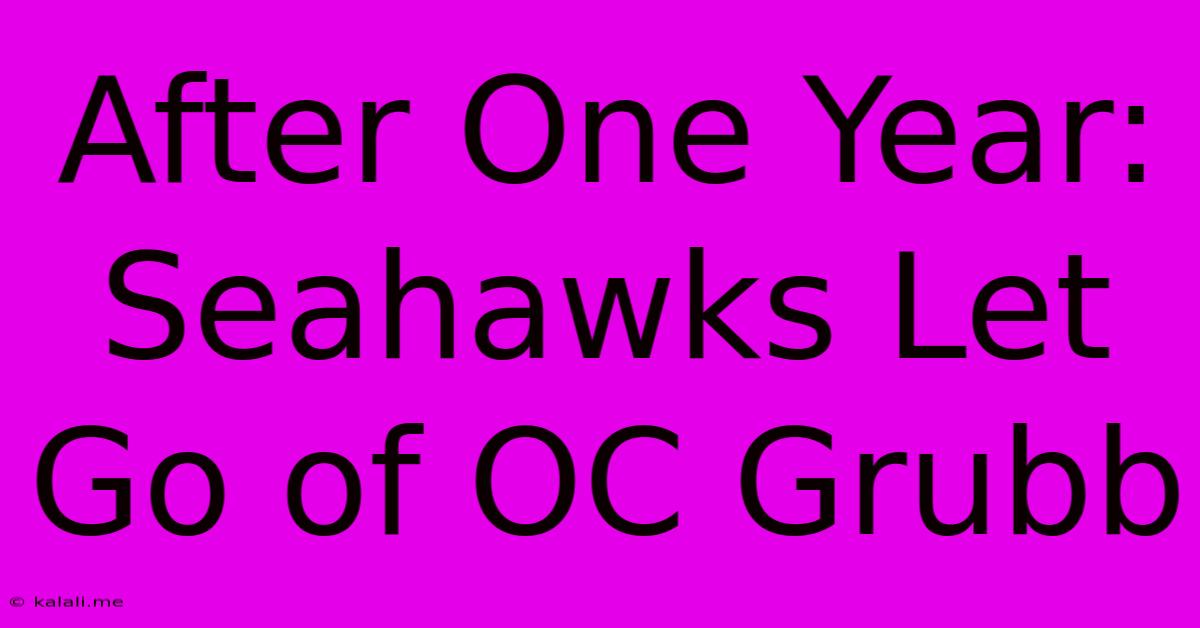After One Year: Seahawks Let Go Of OC Grubb
Kalali
Jan 10, 2025 · 4 min read

Table of Contents
After One Year: Seahawks Let Go of OC Shane Waldron
The Seattle Seahawks' decision to part ways with offensive coordinator Shane Waldron after just one season sent shockwaves through the NFL. While the team showed flashes of brilliance under Waldron's leadership, ultimately the inconsistencies and lack of explosive offensive production led to his dismissal. This move raises crucial questions about the Seahawks' offensive philosophy, their quarterback's development, and the challenges of building a successful offense in the modern NFL.
A Season of Ups and Downs: Analyzing Waldron's Tenure
Waldron's arrival in Seattle was met with high expectations. His background working with Sean McVay in Los Angeles suggested a potential for a sophisticated, high-powered offense. While the Seahawks did show improvement in certain areas, the overall performance fell short of expectations. The team's inconsistency was a major issue; they could dominate one week and then struggle mightily the next.
The Good:
- Improved Passing Game Efficiency: Compared to the previous season, the Seahawks showed improved passing game efficiency in some aspects. The team incorporated more play-action passes and utilized quick-hitting routes to exploit defenses. This improved Geno Smith's completion percentage and reduced turnovers.
- Run Game Potential: The Seahawks running game, featuring Kenneth Walker III, showed flashes of explosiveness. Walker's ability to break off big runs provided a crucial element to the offense. The team's commitment to the run, especially in short-yardage situations, was also a positive aspect.
- Development of Young Talent: While not solely Waldron's responsibility, the development of young players like Kenneth Walker III is a point in his favor. The offensive coordinator helped integrate Walker into the system, allowing him to showcase his considerable talent.
The Bad:
- Lack of Explosive Plays: The Seahawks offense, while efficient at times, struggled to generate big plays consistently. This limited their ability to put up points quickly and often left them playing from behind. A lack of deep threats and inconsistent execution contributed to this issue.
- Red Zone Inefficiency: The team's struggles in the red zone were a major concern. Too often, the Seahawks stalled out inside the 20-yard line, resulting in field goals instead of touchdowns. This cost them crucial points and ultimately contributed to several losses.
- Inconsistent Play-Calling: One of the biggest criticisms leveled at Waldron was his inconsistent play-calling. There were games where the offensive game plan seemed to perfectly counter the opposing defense, while other games lacked a clear strategy, leaving the offense predictable and easily defended.
The Larger Context: Factors Beyond Waldron's Control
It's important to acknowledge factors outside Waldron's direct control that influenced the offense's performance. The offensive line's inconsistency, for instance, played a significant role in the team's struggles. A porous offensive line limited the running game's effectiveness and put pressure on Geno Smith, hindering his performance.
Furthermore, the Seahawks' defense, while solid at times, also contributed to the offensive struggles. Games where the defense faltered forced the offense to play catch-up, leading to more risky plays and potentially more turnovers. This constant pressure on the offense put extra strain on the play-calling and overall offensive execution.
The question of Geno Smith's ceiling also factors into the equation. While Smith significantly exceeded expectations, showcasing improved accuracy and decision-making, his performance still fluctuated throughout the season. Whether he truly represents a franchise quarterback capable of leading a consistent, high-powered offense remains a crucial question for the Seahawks’ future.
The Future of the Seahawks Offense: Lessons Learned and New Directions
The Seahawks' decision to move on from Waldron signifies a desire for a fresh approach. The team needs to address the fundamental issues that plagued their offense in 2022, regardless of the offensive coordinator.
This includes:
- Investing in Offensive Line Talent: A stronger offensive line is paramount for any successful offense. The Seahawks need to prioritize drafting and signing high-quality offensive linemen to improve pass protection and run blocking.
- Adding Explosive Offensive Weapons: The Seahawks need to add players who can consistently create big plays. This may involve drafting a wide receiver with elite speed or acquiring a tight end capable of stretching the field.
- Developing a Consistent Offensive Identity: The Seahawks need to define a clear offensive identity, whether it leans more towards a run-heavy or pass-heavy attack. This would provide more structure and predictability, allowing the offense to run more efficiently.
The Seahawks’ search for a new offensive coordinator will be crucial. The next coordinator will need to address the issues raised by Waldron's tenure, building upon the positives while significantly improving the aspects where the team fell short. The team must learn from their experiences and create an offense that is consistent, explosive, and capable of supporting their franchise quarterback, whoever that may be. The future of the Seahawks hinges on finding the right offensive leadership to complement the existing talent and guide the team towards sustained success.
Keywords: Seattle Seahawks, Shane Waldron, Offensive Coordinator, NFL, Geno Smith, Kenneth Walker III, Offensive Line, Play Calling, Red Zone, Explosive Plays, Passing Game, Running Game, Offensive Philosophy, NFL Offseason, Coaching Changes, Team Strategy.
Latest Posts
Latest Posts
-
How Much Is 120 Kilograms In Pounds
Jul 12, 2025
-
Born In 1990 How Old Am I
Jul 12, 2025
-
What Is The Average Iq For A 5 Year Old
Jul 12, 2025
-
How Many 12 Oz Cups In A Gallon
Jul 12, 2025
-
How Much Older Is John The Baptist Than Jesus
Jul 12, 2025
Related Post
Thank you for visiting our website which covers about After One Year: Seahawks Let Go Of OC Grubb . We hope the information provided has been useful to you. Feel free to contact us if you have any questions or need further assistance. See you next time and don't miss to bookmark.